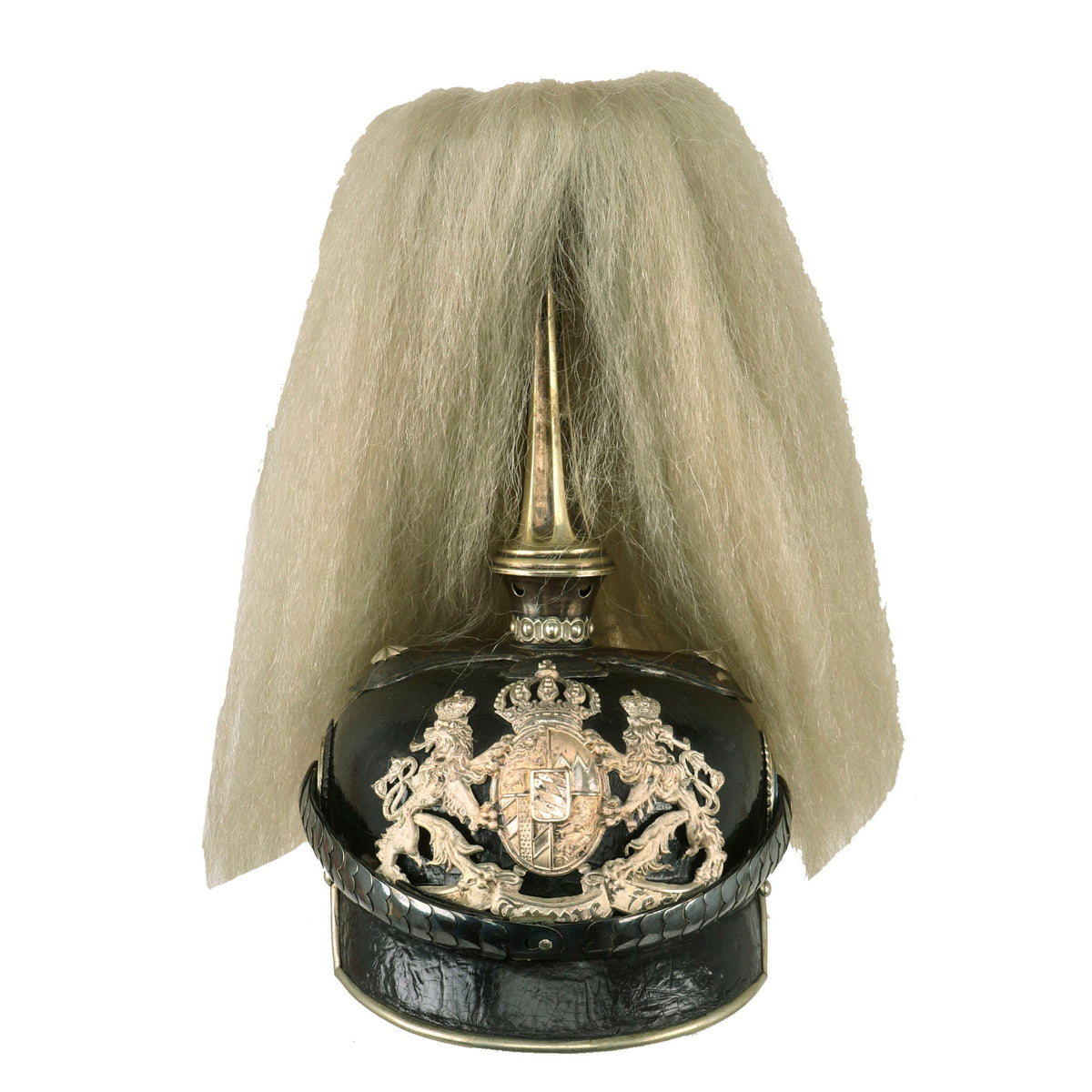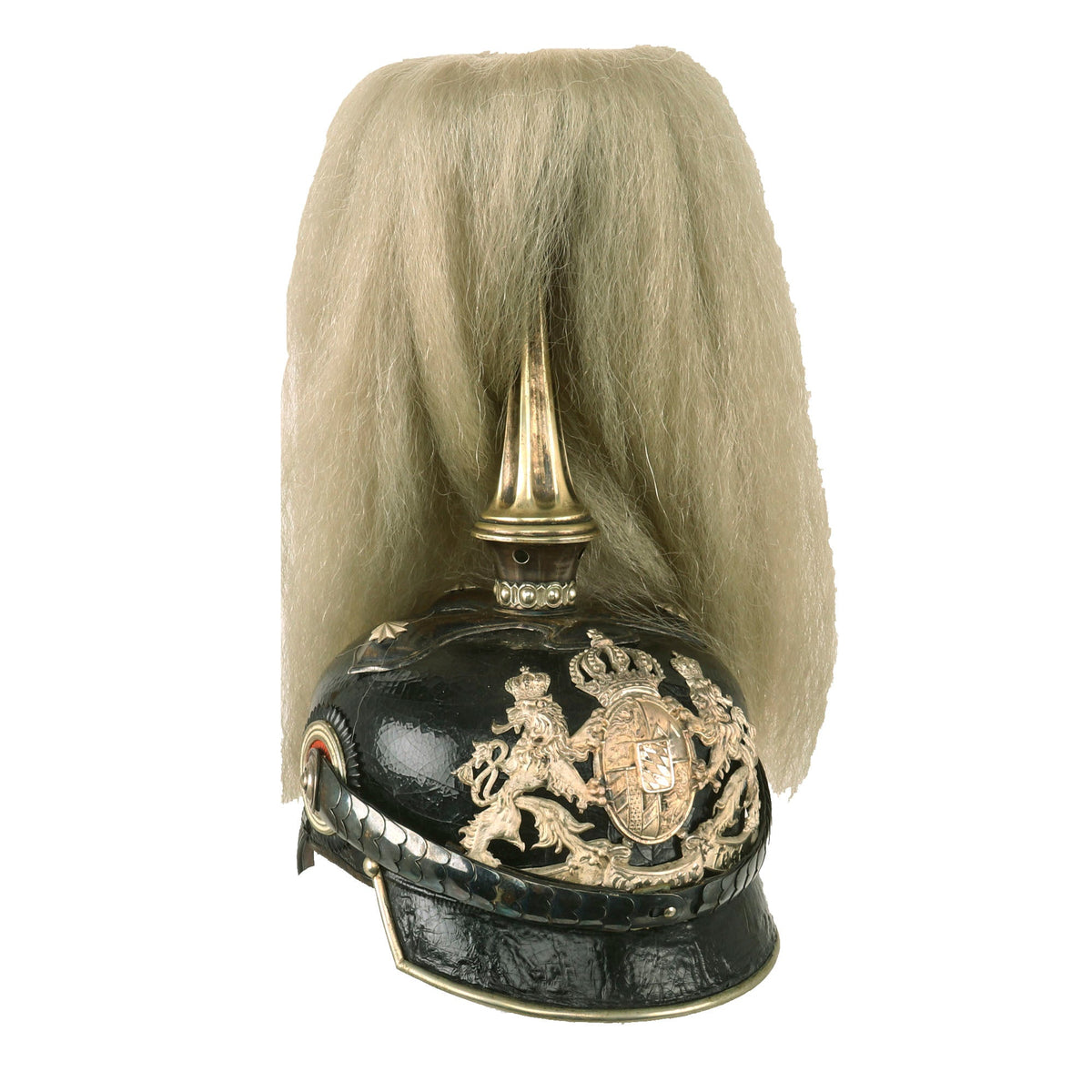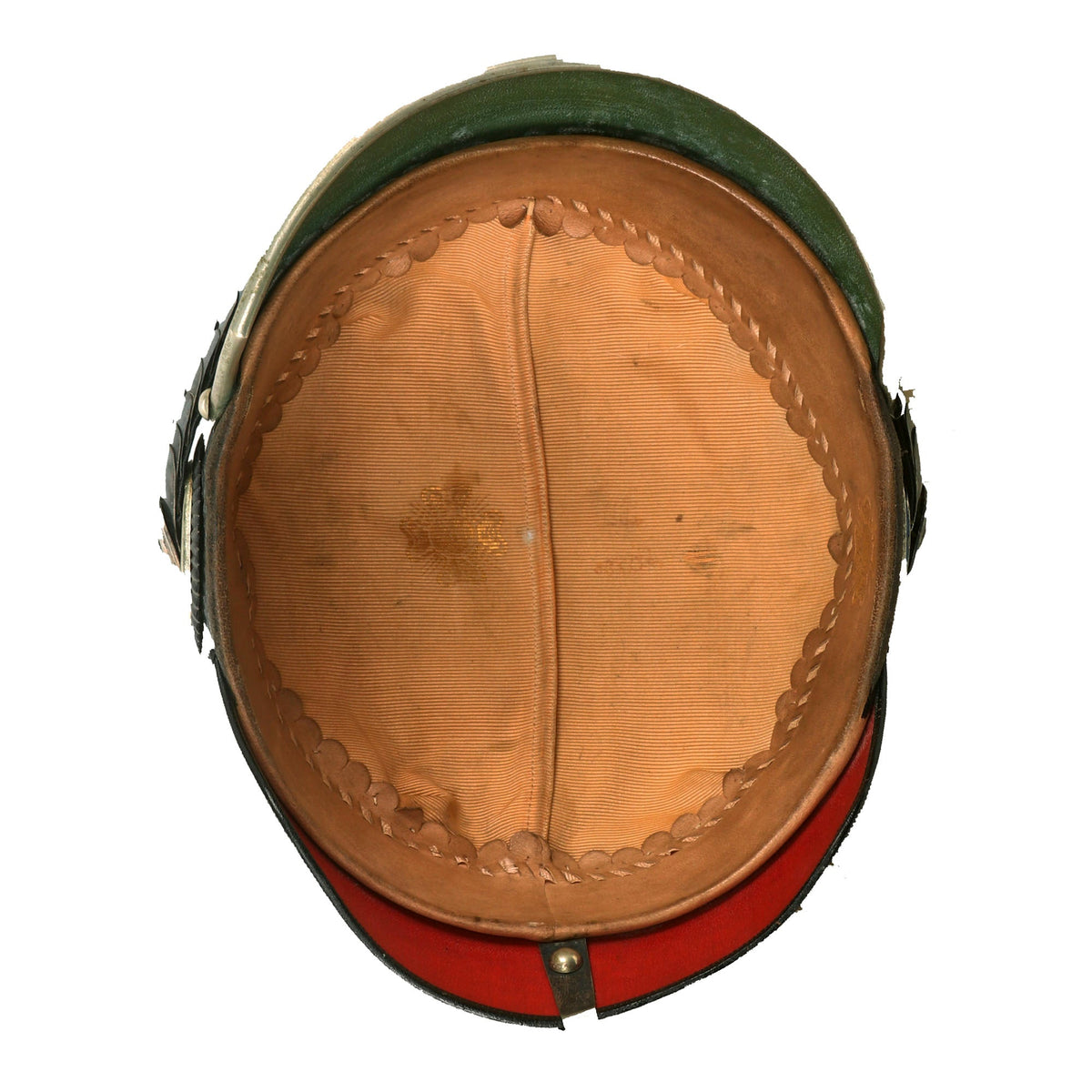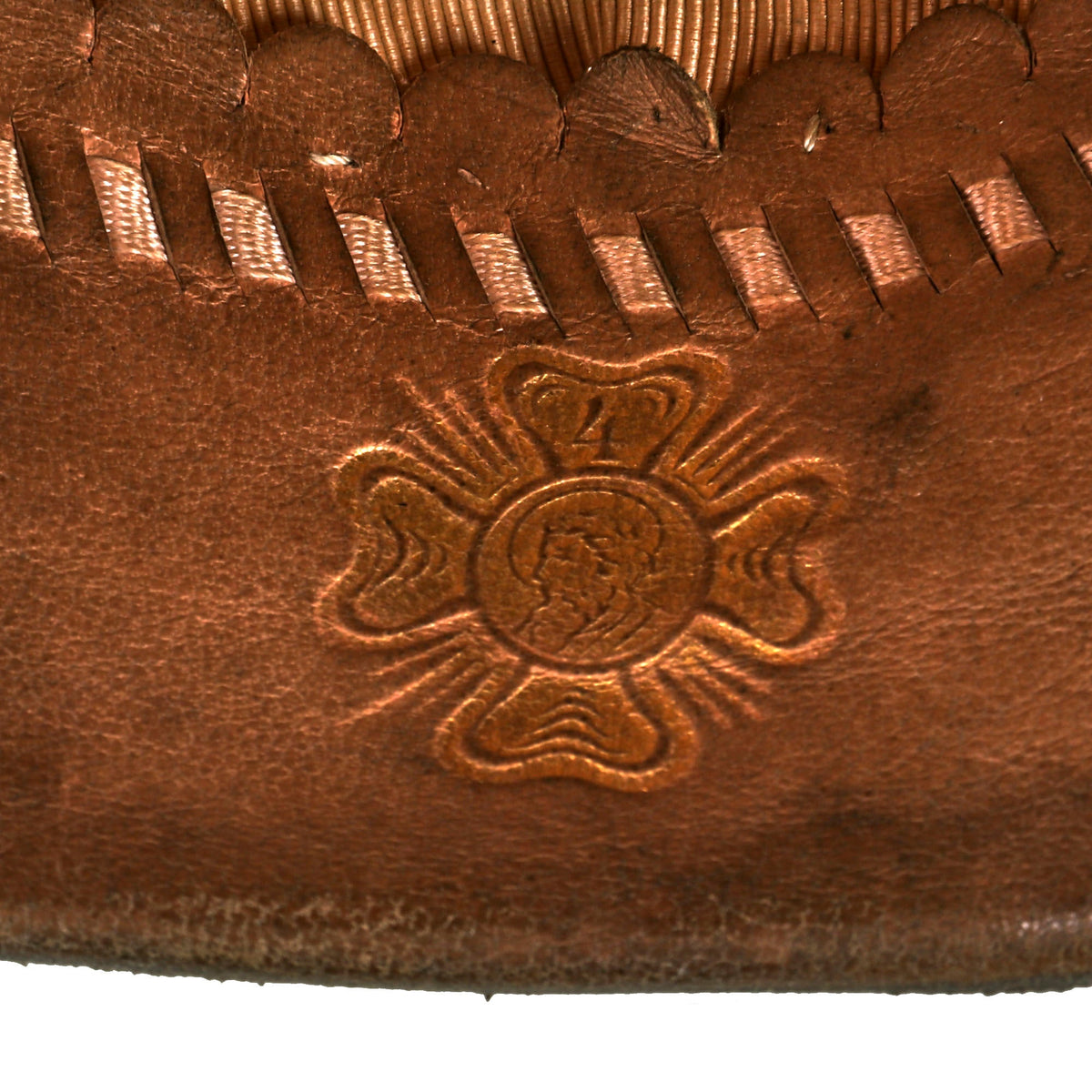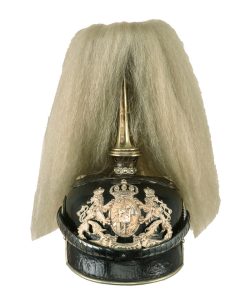Original German WWI Bavarian M1886/14 Chevau-légers Cavalry Officer Pickelhaube Helmet with Tall Spike and White Plume Original Items
$ 2.395,00 $ 598,75
Original Item: Only One Available. This is a traditional German first world war Bavarian Officer’s Neusilber (German or Nickel Silver) mounted leather helmet known as a Pickelhaube, set up with a red plume on the spike, indicating Cavalry issue. While this one is not marked with a specific regiment, he specific combination was only worn by the Königlich Bayerisches 1. Chevaulegers-Regiment (Royal Bavarian 1st Chevau-légers Regiment), as well as the 2nd, 4th, 6th, and 8th. These light cavalry units were all entitled to wear a helmet Trichter (funnel spike) and Haarbusch (parade plume) on parade. This example is definitely upmarket, as a good amount of the hardware is silver plated, in addition to being made from nickel silver.
The M1886 Bavarian Pickelhaube was the final evolution in a long series of spiked helmets, and is very similar to the Prussian version. The M1886 version features a cruciform spike base on ALL helmets, both enlisted and officer. The star retaining pins on the base definitely identify this as an officer. It also has a correct M1886 modified wappen, which does not have the branches and Laurel-leaf ornamentation around the Lions, as they were often removed in 1914.
Like all pickelhauben, it was manufactured from boiled leather, lacquered black, and provided with fittings made of brass or German silver, dependent upon the Regt. The protection it offered was very limited and led to the eventual replacement by a steel helmet in 1916. Regardless of the unit, officer Pickelhaube share common features such as: the undersides of visors are lined with red and green, larger and more ornate officers kokarden were attached, and “egg & dart” Perlring was utilized around the base of the top spike.
This helmet features a correct large model 1886/14 wappen (front plate) with the Bavarian coat of arms marked on the bandeau with the kingdom’s motto, In Treue Fest, German for “steadfast in loyalty.” The wappen is held in by the correct square brass nuts bolts used on officers models. The convex brass chin scales are in great shape, with complete leather backing front clasp and intact buckle. The only difference between an Infantry officer’s helmet and a Cavalry officer’s helmet (and Artillery until the adoption of the ball spike in 1916), is that infantry chinscales are flat, while Cavalry and Artillery chinscales are curved like this one.
It is complete with correct multi-piece officers Bavarian (blue and white) and German National Colors (red white and black) Kokarden (cockades) around the chin strap lugs. In 1897 the new Reichs-Kokarde in Red-White-Black was introduced for all ranks to commemorate the 100th anniversary of the birth of Kaiser Wilhelm 1st. The Reichs-Kokarde was to be worn on the right side of the helmet, and the state Kokarde was moved to the left, as on this helmet.
The interior of the helmet still retains the leather sweat band as well as the cream silk skull cap. There is no major damage to either, just the typical and expected wear from use and age. There is a maker marking embossed into the leather, which is also lightly marked into the skull cap.
The black leather shell shows the expected cracking, crazing and wear due to age, which makes the black lacquer brittle. It is still mostly shiny, and really has a great look to it, impossible to duplicate without waiting 100 years. There is also a level of leather shrinkage due to age, the reason some of the fittings are somewhat loose. The very top of the helmet is a bit sunken in, very common if they are unsupported on the interior.
The correct square front leather visor has nickel silver trim in very good condition, still tight to the visor, which has some finish crazing as often seen. It still retains the correct green lining on the underside. The metal spine that descends from the spike’s baseplate to the edge of the rear visor is also in very good condition, and the rear visor still has full edge trim as well as the red finish underneath. The stitching holding both the front and rear visors is still mostly intact though there is a bit of movement due to the stitching deteriorating.
Overall an extremely nice condition Bavarian Chevau-légers Officer pickelhaube, a great addition for any serious collector.
Fast Shipping with Professional Packaging
Thanks to our longstanding association with UPS FedEx DHL, and other major international carriers, we are able to provide a range of shipping options. Our warehouse staff is expertly trained and will wrap your products according to our exact and precise specifications. Prior to shipping, your goods will be thoroughly examined and securely secured. We ship to thousands clients each day across multiple countries. This shows how we're dedicated to be the largest retailer on the internet. Warehouses and distribution centres can be located throughout Europe as well as the USA.
Note: Orders with more than one item will be assigned a processing date depending on the item.
Before shipping before shipping, we'll conduct a thorough inspection of the items you have ordered. Today, the majority of orders will be delivered within 48 hours. The delivery time will be between 3-7 days.
Returns
The stock is dynamic and we cannot completely manage it because multiple stakeholders are involved, including our factory and warehouse. So the actual stock may alter at any time. It's possible that you may not receive your order once the order has been made.
Our policy is valid for a period of 30 days. If you don't receive the product within 30 days, we are not able to issue a refund or an exchange.
You can only return an item if it is unused and in the same state as the day you received it. You must have the item in its original packaging.
Related products
Uncategorized
Uncategorized
Uncategorized
Uncategorized
Uncategorized
Uncategorized
Uncategorized
Uncategorized
Australian WWII Owen MK1 Machine Carbine SMG Custom Fabricated Replica with Sling Original Items
Uncategorized
Angolan Rebel 1970s era 60mm Inert Display Mortar from Angolan Civil War Original Items
Uncategorized
Uncategorized
Uncategorized
Uncategorized
Uncategorized
Uncategorized
Uncategorized
Armored Burgonet Helmet & Polearm from Scottish Castle Leith Hall Circa 1700 Original Items
Uncategorized
Uncategorized
Uncategorized
Uncategorized
Band of Brothers ORIGINAL GERMAN WWII Le. F.H. 18 10.5cm ARTILLERY PIECE Original Items
